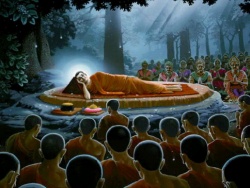Difference between revisions of "Grāhya-grāhaka"
Jump to navigation
Jump to search
| (One intermediate revision by the same user not shown) | |||
| Line 1: | Line 1: | ||
[[File:56581 n.jpg|thumb|250px|]] | [[File:56581 n.jpg|thumb|250px|]] | ||
| − | + | [[Grāhya-grāhaka]]([[Sanskrit]]). The ‘[[grasped]]’ and the ‘[[grasper]]’; a [[Yogācāra]] term for the [[duality]] of a perceiving [[subject]] and [[perceived]] [[objects]]. The school [[attributes]] the [[perception]] of [[duality]] to a false [[imagining]] ([[abhūta-parikalpa]]) which fabricates and superimposes upon [[reality]] the [[idea]] of a [[conscious]] [[self]] which [[perceives]], and the [[objects]] which are [[perceived]] by it, thus generating [[saṃsāra]]. | |
{{R}} | {{R}} | ||
[http://www.answers.com/topic/gr-hya-gr-haka www.answers.com] | [http://www.answers.com/topic/gr-hya-gr-haka www.answers.com] | ||
[[Category:Sanskrit terminology]] | [[Category:Sanskrit terminology]] | ||
[[Category:Yogacara]] | [[Category:Yogacara]] | ||
Latest revision as of 03:35, 30 December 2013
Grāhya-grāhaka(Sanskrit). The ‘grasped’ and the ‘grasper’; a Yogācāra term for the duality of a perceiving subject and perceived objects. The school attributes the perception of duality to a false imagining (abhūta-parikalpa) which fabricates and superimposes upon reality the idea of a conscious self which perceives, and the objects which are perceived by it, thus generating saṃsāra.
